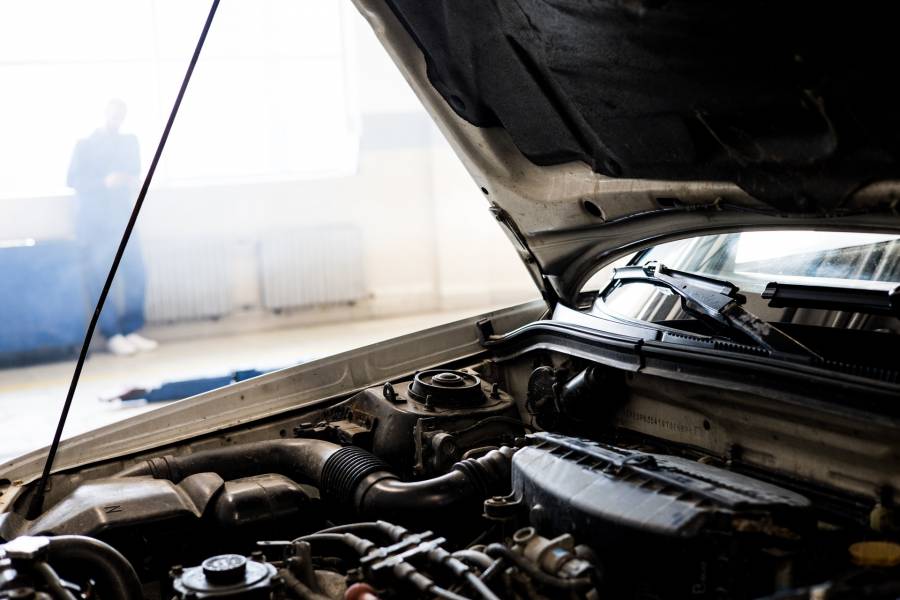Quick Navigation
A Brake Booster Vacuum is the master cylinder setup attached to your engine to minimize the pedal pressure needed to brake your car.
This system creates a vacuum to overpower fluid pressure in your car’s brake.
This system improves your car’s brake safety, so your brake responds fast when you need to stop quickly.

The brake booster vacuum line works in conjunction with the brakes and master cylinder to enable the brake to work correctly.
If the Vacuum line leaks, develops a tear or splits, you will not feel the brake as responsive as it used to be.
Let’s take a quick look into the possible causes of a brake booster vacuum leak and their solutions. Read along!
Causes Of A Brake Booster Vacuum Leak And Their Solutions
Before discussing the causes of a vacuum leak, note that a leak is a leak between the mass airflow sensor and the engine.
You can find this mass airflow sensor in the air filter box of most cars.
Now the mass airflow sensor measures the airflow to the engine. The PCM then calculates the amount of fuel based on the mass airflow sensor measurements.
If there’s a leak, unmetered air will enter the system.
Hence, causing the PCM to miscalculate, the engine system will run lean, allowing too little fuel and too much air into the engine.
Cracked Or Broken Hose
The primary cause of a brake booster vacuum leak is having cracks on your vacuum hose. There can also be leakage from your car’s throttle body gasket.
Finding a vacuum leak is not always an easy task, even if it may seem easy. There are many parts of your engine that can cause a vacuum leak.
If you suspect you have a brake booster vacuum leak, you would have to search around your engine for it.
Solution
If you suspect that it’s leaking as a result of a broken or cracked hose, here is what you would do:
- Jack up your car after placing wedges on the tires you wouldn’t lose.
- Take off the tires that lead to the braking house to gain easy access. In some car models, you will find a metal covering the brakes; take it off.
- Remove the master cylinder, which is located at the top of the brake assembly, to gain access to the brake booster vacuum hose.
- Remove the hose and install a new hose, after which you slide the master cylinder back into its place.
- Bleed your brake lines to release the air trapped inside any brake lines, and you’re good to go.
- Test your brake to see its efficiency, then replace your car tires and bring them down.
Intake Snorkel
Another cause of a brake booster vacuum leak is a bad intake snorkel. The snorkel is a plastic or rubber duct that links the air filter box and the engine.
This snorkel can crack or rip, leading to a leak.
Solution
To repair the intake snorkel, you have to replace the rubber. While getting a new rubber, get the worn gear clamps that secure the rubber at both ends.
If the intake rubber is not installed correctly, there will still be leakage.
Intake Gasket And Manifold
The intake manifold and gasket are a part of the engine head. This manifold warps over time.
The O-rings and gasket that seal the gaps shrink and become hardened. It will lead to a vacuum leak.
Many cars even use plastic intake manifolds, which are prone to leakage.
Solution
To fix the intake manifolds and gasket, you also must replace the worn sides. You can get the O-rings and gasket cheaply, but the manifold is where there’s a problem.
It’s pretty expensive and quite hard to disassemble.

Positive Crankcase Ventilation System
The PCV system is another cause of this leak. The positive crankcase ventilation system removes oil vapor and gases from the engine crankcase.
When this system collects the oil from the vapor through the oil separator, the vapor goes to the engine intake through a valve.
Over time, the plastic and rubber parts of this PCV can crack or fall apart during high mileage leading to a vacuum leak.
There is a rubber diagram inside the PCV valve that also fails from use, and this can also cause leakage. You have to be aware of these things.
Solution
You also have to replace any cracked rubber and plastic hoses. For the PCV system, you have to replace the failed parts.
The parts are not costly, but the PCV system is fixed under the intake manifold in many cars, and removing an intake manifold is intensive.
EGR Valve
The EGR Valve can also cause a vacuum leakage. The EGR valve links the intake manifold to the exhaust.
When the car is at high speed, the valve opens, but it can get stuck because of carbon buildup.
When the valve is left open for so long, a vacuum leak is created, allowing exhaust gas into the manifold instead of air.
Solution
To solve the issue with a stuck EGR valve, you would have to replace it, and it doesn’t come cheap, so be prepared when you go to see your mechanic.
How To Find A Vacuum Leak
There are different ways to use in finding a vacuum leak. Let’s point out some of them here:
- The fastest and easiest way to see if you have a vacuum leakage without any tools is to spray flammable liquid around various areas of your engine carefully. These areas include the intake manifold gasket, vacuum hoses, brake booster hose, solenoids & actuators, and around the throttle. It will result in the engine absorbing this liquid and combusting the fluid. There will be an instant RPM raise, and the leakage area will be noticeable.
- If you’re not careful with this method, you may set your car on fire. It is advised that you do this outdoors and don’t spray close to your ignition or hot parts of your engine.
- You can also visually inspect your car’s vacuum hoses for cracks and breakage. Vacuum hoses are made of rubber which becomes rigid and starts to crack along the line. If you find any hard or cracked hoses, replace them immediately.
- You can also use soap and water to find leaks as well. This method works best when air is pushed out. With the help of the soap, you can determine where the leakage is coming from.
- You can also use an EVAP smoke machine to find the vacuum leaks in a super-fast way. However, you may need to buy or rent the machine for this purpose which is the only downside to this method.
Conclusion
With the few symptoms listed, you should be able to detect when your brake booster vacuums leak and how to find the cause.
When you detect the cause, you should be able to fix or replace whatever has gone bad and is making your car brake vacuum leak.

Kevin has been hanging around cars and automobile magazines since he knew what a car is. He grew up in his father’s 1995 Mercedes E320 Wagon and Volkwagon Phaeton W12 2004. He rides his first car, a manual 1979 Porche 911SC.
Currently, he owns an Acura Integra GS-R. During his childhood, he showed a keen interest in how things actually work and fix them. This passion transforms into his eternal love for cars and bestows him an ideal position in one of the leading automobile companies; whenever he finds time, he takes out his Acura and opts for the longest possible route to find hidden wholesome pleasure in a road trip.
Want to read some of the articles written by Kevin? Head to our blog section to find out all the articles written by Kevin.






